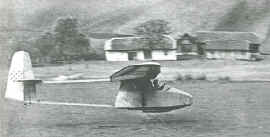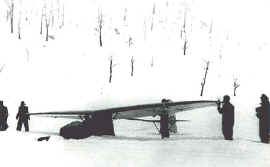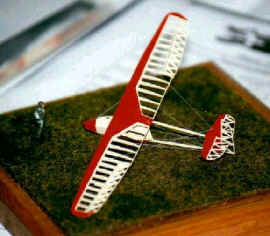|
Ground crew preparing Salamandra for flight NOTE THE NATIONAL INSIGNIA ON LOWER SIDE of RIGHT WING
In March 1941, the Yugoslav Government signed a treaty which enabled Yugoslavia access to Axis Bloc countries. On 27th March, following mass demonstrations against this treaty, the military overthrew the government. The Axis struck on April 6th,1941,with a devastating air raid on Yugoslav capital, Belgrade. At the same time, the German, Italian, Hungarian, Rumanian and Bulgarian armies crossed the border, crushing the ill-prepared Yugoslav army.
Once the country was conquered, they split the former Yugoslav territory between them. To facilitate control of the occupied territories, Germany formed the so-called Independent State of Croatia, or Nezavisna Drzava Hrvatska ( NDH ) in original.
Formed on territory with predominantly Croatian population, the new state quickly formed its own Air Force, called Zrakoplovstvo. The range of aircraft types which served in it was really fantastic - more than 60 different types went trough the hands of Croatian pilots.
About Salamandra
The WWS-1 Salamandra was originally Polish design. Until now, it’s not clear where they came from to Croatia. There are two possibilities – they may be captured ex-Yugoslav gliders, bought direct from Poland, or supplied by Germans after occupation of Poland. However, totally some 20 of them served in Croatian air force,
most of them in Sveta Nedjelja Air school. They’re used for primary gliding lessons, towing by plane, or winch. They were so simple, that even instrument panel was omitted. Interior was spartan - the stick, the seat and rudder pedals. Construction was wood, with fabric cover. Leading edge of wings, and stabilzators were planked wood . The whole construction was strengthened with steel wires.

|

|
|
Landing on Sveta Nedjelja airfield, Summer 1942
|
Learning’ to fly in snowy conditions – Winter ‘41/42
Note that whole fuselage is painted red.
Towing plane (out of this picture) has skis instead wheels.
|
The model
I’ve found the plans of this little glider, and decided to scratch built it. First, I photocopied plans to proper scale - the Salamandra is a tiny model, only 7 cm long, with 14 cm wingspan. I started with horizontal stabilizers I cut them from plastic telephone card, but any sheet styrene 0.9 mm thick will be good. Then I cut the elevators off. There are used later as jig for trailing edge bended from 0.4 mm diameter copper wire.
When stabilizers are sanded to shape, trailing edge was glued with cianoacrylate to them. Ribs are made from 0.5 cm thick styrene sheet, glued between stabilizers and elevator trailing edge, then sanded to shape, too.
The same procedure was used to build vertical fin and rudder.
Since the leading edge of wings is cowered with plywood, I used thicker ( 2.8 mm ) styrene sheet to form it. Construction is similar to one used on fins, only here was necessary to add second spar, on which ailerons are hinged.
I first built fuselage frame, then cower it with 0.5 mm thick styrene and then added lower fuselage bar.
I used only three colors on this model - Scarlet red ( FS 31302 ), Fabric ( FS 33729) and Dark Gray for tension wires ( any dark gray is OK ).
After the subassemblies was painted, finally started assembly. I first super glued vertical fin and rudder to lower fuselage bar, then wings to fuselage. When this was set, I glued upper fuselage bar to upper side of wings with one end, and to vertical fin on another. After gluing the horizontal fin subassembly, the major part was done.
After all has set, I added wing’s and stabilizer’s struts, skid, and thru cockpit opening seat, seatbelts, rudder pedals, control stick and headrest, all of them painted before gluing to model. Finally, tension wires are added made from stretched sprue, and paint before gluing, too.
|
Conclusion
I didn’t count how much time I spent on building this beauty, but believe me, every minute was fun. Cutting and assembling all those ribs may seam tricky, but, with a lot of time included, patience is all you need. The three view plans are available by author.
Photographs
All b/w photos are provided courtesy by
Mr. Danijel Frka, Croatia
Photo of finished model
Mr. Nenad Setina,Croatia
|

|
|
WWS – 1 SALAMANDRA
1 / 72 SCALE
|
|